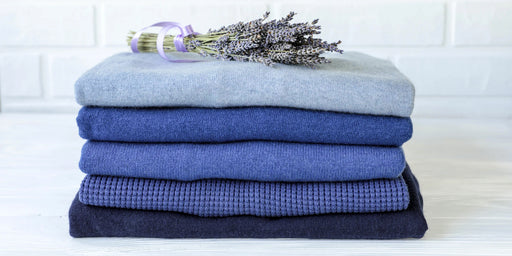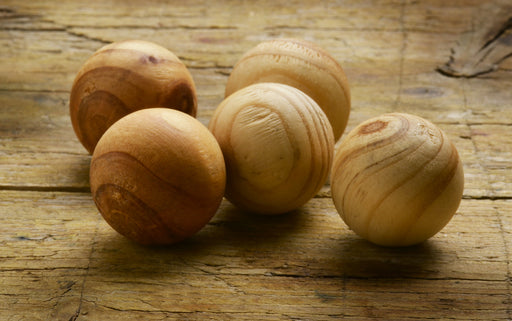How To Store Cashmere - 9 Step Guide

Luxury investments like cashmere require knowledgeable care all year round in order to maintain the luscious softness and reliable durability of its fine, natural fibers. Here, we’ll explore everything you need to know about properly storing your favorite pieces.
Matter of Facts: What is Cashmere?
It’s goat hair, but not just any goat hair. In the Kashmir Valley between the borders of India and Pakistan lives a breed of goat prized for its soft undercoat and sturdy guard hairs. When gathered, cleansed and spun into yarn for weaving textiles, these goat hairs create the world’s most expensive wool: cashmere.
For more on what is cashmere, head over to our post.
Historical Context
Cashmere became known as such due to the association that western markets made with one of the first cashmere garments to ever be sold, which were scarves known as Kashmir shawls. Local traditions vary on how these goats were brought to the valley itself, or who first thought to gather their supple undercoats for making wool.
However, it’s generally accepted that cashmere wool was manufactured in the region for thousands of years before 18th century trade brought herds and manufacturing practices to European areas. Now, the cashmere or pashmina breed of goat can be found all over the world.
Purists and strict cashmere enthusiasts might insist that wool gathered from goats not living in the Kashmir Valley is still substandard compared to those that do, even if they are the same breed. This may arise due to their accounting for the influence the climate of the Kashmir Valley must have on the strength and warmth of the fibers in the final product.
Modern Trends
Centuries later, cashmere still reigns supreme compared to other expensive, high-class textiles. For many, the breathable durability of most natural fibre materials will always outrank synthetic blends. In the case of cashmere, few wools can compete with how warm it wears for how much it weighs.
Quality cashmere will always cause a bit of sticker shock, but bargain buys aren’t always a bad idea when it comes to luxury goods like this. Cashmere of a mid-range quality is still supple and insulates well, so you can round out your wardrobe without breaking the bank by purchasing different grades of cashmere.
Second-hand cashmere holds its value well, and all the more if the original - or second, or third! - owner stored it well. Even if you find a thrifted piece that has a stain or two, you may be able to save it with a few of our clever tricks. Just make sure you take extra care of second-hand pieces when it's your turn to put them in storage!
Why Does Proper Storage Matter for Cashmere?
Sure, it makes sense to take care of your belongings no matter their cost - but there’s much more behind the rules of storage for cashmere than good manners and tidy habits.
Longer Lifespan
When you’re storing cashmere properly, the kind of care you’re giving those natural fibers will keep them soft and vibrant for years, even decades. Perhaps even centuries, though curators would likely throw a fit if anyone stepped out for a night in cashmere that was over one hundred years old.
While extremely antique pieces are more likely to be professionally preserved rather than worn in the winter or stored in the closet over the summer, there’s no reason not to hope for a lifetime or more of use from any quality piece of cashmere you buy. Provided, that is, you maintain your best storage practices through those years.

Cashmere Pest Prevention
Once infested, clothes moths can be incredibly tricky to exterminate. That’s why taking precautions early on is so important. The earlier you can catch an infestation, the more hope you have of saving your cashmere before it becomes a nursery room snack for moth larvae. Use zippered storage bags and suit covers that blend a breathable cotton canvas with see-through plastic windows so you can take a peek inside without opening it up every now and then.
Aside from storage, how do you keep clothes moths away from your precious cashmere? Natural clothing moth pheromone traps and tried-and-true natural oils work wonders but remember not to use them near each other as this will affect the pheromones in the moth traps. If you’re already using natural deterrents, remember that products like cedar wood blocks and lavender sachets only work when their oils are fresh, so be sure to replace or renew any that have lost their potency.
Damage Control
Clothes moths aren’t the only thing that could be lurking in the dark of an improperly kept storage space. Bacteria, fungus and maybe the next scientific breakthrough could be growing if you haven’t explored that particular corner of your closet before stuffing your cashmere in there.
And that’s not to mention what could crop up on the garments themselves. An important part of proper storage is making sure you’re storing pristinely clean items. However, certain natural body oils and perspiration stains won’t show up until the individual fibers of the garment relax and release them. Left alone, these could attract moths, or simply weaken the bonds between the fibers and cause frays, pills or unraveled seams.
Storage Basics for Cashmere Garments
First, we’ll settle a few age-old questions and then we’ll dig into the step-by-step technique below.
Hang vs. Fold?
Consider this a settled matter rather than a hotly contested debate. Folding your cashmere belongings will always - always - be a better storage choice than hanging them.
These natural fibers are durable, that’s certain. But under certain conditions, natural fibers can also become quite vulnerable to damage. No matter how light cashmere wears compared to other wool textiles, its own weight causes enough tension that it can stretch the bonds between each strand of yarn loose. It’s not always easy to reshape those garments, either.
Summer vs. Winter?

While cashmere is more closely related with winter-time wear than it is with summer outfits, you can still find pieces that are comfortable and wearable all year. However, most people probably have more cold-weather cashmere than they do otherwise.
Naturally, storing your cashmere while you’re still likely to wear it more than once a month requires a different technique than long-term storage does. First, it may seem counter-intuitive, but you shouldn’t wash cashmere every time you wear it. It’s okay to wait a wear or two between washes if you’re just donning the garment for a few hours at a time now and then.
More rigorous cashmere wear, or obvious staining, would require immediate washes, of course. You can pop these items back into your long-term cashmere storage bags for extra precautions if you’re worried about a sudden appearance of small, flying and desperately unwanted visitors. If you do this, though, make sure you wash your storage bags before following the long-term storage tips below.
Prepping Cashmere for Long-Term Storage
Specialty textiles like cashmere garments need a lot more than a wash-and-fold to ready them for a seasonal slumber.
Step 1: Gather your Cashmere
This may seem like a frivolous first step, but you’d be surprised what really turns up once you set your mind to looking for it. Even prized possessions like high-quality cashmere can wind up misplaced, or borrowed and swiftly forgotten.
Even if you have cashmere pieces in long-term storage already, pull them out with the rest so that you can start your new season of cashmere hibernation off fresh. This can help you see at a glance if you’ve outgrown your storage space with any recent purchases, or if you can let go of anything to shrink your space.
Step 2: Assess your Cashmere Garments
If you have quite the collection of cashmere, you may need to schedule a full day for this - but it’s important that you look over every piece. There may be stains or snags you haven’t seen yet, and you should take care of these issues before you even wash the piece, let alone store it.
Step 3: Repair damaged Cashmere Clothes
Any major repairs may need the attention of a skilled seamstress, so if that’s not you already, set some time aside to take care of that before you wash the item. You don’t need to wait on these to prepare the rest of your cashmere for storage, however.
Simpler repairs may include depilling the garment, which is easy to do with a cashmere or wool comb, or a fabric shaver. If you don't have these supplies on hand and you’re only dealing with a few stray fuzzballs, you could have success with a pair of fine-tipped scissors and a steady hand.
Step 4: Cashmere Stain-removal
Since cashmere and other natural textiles like it need mild detergents and react poorly to heavily perfumed, strong soaps. This presents a bit of a challenge when it comes to removing stains, which typically need some potent products to lift them out of fabric.
While you should never use bleach or other harsh cleansers, you can spot-treat stains on your cashmere with cool water, a dollop of your usual wool-safe detergent and a lot of gentle blotting. When in doubt, let the soap soak in for a bit before returning to blot the spot again.
Read more on our blog about removing stains from cashmere.
Step 5: Clean
The very best way to avoid any transfer of stains or colors between garments is to wash each one separately. If your collection of cashmere looks like it would fit in a department store instead of the hall closet, get ready for a workout - but one that’s worth it in the end.
Clean cashmere is long-lasting cashmere, so make sure you’ve washed yours thoroughly if it’s headed for long-haul storage time. If you think your cashmere would benefit from a soak, you can leave it submerged for 10-30 minutes.
For more on washing cashmere, click here for a link to our article.

If it’s your first time washing that piece, however, check for color-fastness by washing a small inner seam and checking for transfer by blotting a towel on the spot.
Step 6: Dry
Just as you should never hang cashmere in storage, you should never hang it while wet. What we said about the weight of the garment stretching strands out of shape is even more true when the garment is wet. The added weight of the water isn’t the only issue - wet cashmere can shrink or become otherwise misshapen when handled poorly.
Remember to squeeze excess water from the cashmere against the side of an empty tub or bowl before lifting it up or trying to unfurl it over a drying surface. Your best move is to lay cashmere pieces out between two layers of towels. From there, you can press into the cashmere gently to pick up more water, or roll it into a loose spiral for the same effect.
Step 7: Protect
Not everyone has room, or the budget, for a full cedar chest and its moth-repellent properties, but you can still enjoy the benefits of natural deterrents like these in other ways. Balls and blocks made of cedar are popular choices because they’re easy to tuck into corners and just need to be refreshed each season. Lavender is also a welcome fragrance in most closets, unless you’re a moth.


Replace any old products with new for each long-term storage season. If you notice they’ve lost a certain potency at any point, you may need to replace them more often.
Our refillable Pheromone Clothes Moth Traps give off a powerful pheromone that only the flying adult moth can smell - the MothPrevention Clothes Moth Traps are effective for a full 3 months (compared with most others which are only effective for 2 months or less). You can also buy the refills for our Clothes Moth Traps which isn't possible with all Clothes Moth Traps.
Tissue paper can also help keep the layers of cashmere separate from each other. Not only can this prevent moths from burrowing deeper into a garment, risking irreparable damage, but it also keeps the natural fibres of the cashmere from compression damage.
Step 8: Store
Now comes the part where you get to put your beloved cashmere sweaters and shawls away - but you’re not putting them on a bare shelf with nothing to protect them from the elements, right? No matter how safe you think your closet is, your cashmere is better off in a breathable, zippered garment bag.
These come in a variety of sizes, so one that fits even the most awkwardly shaped closets can be found. You may find combination suit covers and shelved canvas storage, too, so that you can pair your formal winter wear’s long-term storage solution with your cashmere’s.
Step 9: Rotate
Learning how to store cashmere is as much of an art as it is a science, so you’ll develop a feel for when it might be time to air out your cashmere collection during long-term storage. While it needn’t be every month in most climates, you shouldn’t wait longer than three to give your stored cashmere some fresh air and careful inspection.
Speaking of rotating - do you have cashmere in storage right now that could use some breathing room? Make a note to check on those hibernating pieces sooner rather than later!
Once you understand how to store cashmere sweaters and other cashmere garments properly, each of these steps will transition seamlessly into your normal laundering routines. Remember that as long as you maintain these good storage practices from season to season, you greatly improve the odds of securing that long-lasting lifespan that has given cashmere its fame and fortune throughout history. Even if it may take a season or two to master the process, rest assured this is one skill where practice keeps things perfect.
You can learn more on our blog about cashmere care. For more tips on folding and storing sweaters, check out our post!
FAQs for How to Store Cashmere
Now that you know all about the origins of cashmere, why caring for your cashmere garments is so important, and how to store cashmere sweaters safely, let’s go over some frequently asked questions about storing garments of this kind properly. We’ve put together some of the most common questions about cashmere storage from Google to save you time if you want to skim through things to get to the point!
How do you store cashmere to prevent moths?
Clothes Moths are an enemy of cashmere clothing. The larvae of the common Clothes Moth love to consume animal based fibers like wool, silk, and yes, cashmere. If you really want to keep your cashmere garments safe, cedar chests, wardrobes, shelves, and other similar options made of cedar wood are the number one go-to to look into.
Cedar naturally repels moths which helps to prevent nesting and tends to keep moths from inhabiting places where your clothes are stored. Indeed, the use of cedar is an ancient moth prevention technique that has been used through the centuries to keep cashmere in top condition! In fact, cedar construction as a luxury way to protect goods can be traced back to the temple of Solomon in ancient times.
With that being said, not everyone can afford top-dollar cedar shelving, wooden chests, etc. If cedar furniture or construction will not work as a viable option for protecting your cashmere garments, there are still some affordable ways to use this wood to keep your clothes safe. Spheres and cubes made of cedar are an affordable alternative to consider. Although these little pieces of wood need to be refreshed each season, they are a fantastic solution for people looking to naturally and affordably prevent moths. The cedar spheres are best, as they don’t have sharp corners that can snag on loose cashmere fibers. Moth-repellent sachets that contain lavender, cedar, time, and rosemary, are another fantastic option to consider.
How to store cashmere sweaters for the summer?
Cashmere is definitely a luxurious and cozy winter fabric. It's soft, it's warm, and it's beautiful. What better way to feel and look your best on a frosty winter's day?
When considering how to store cashmere sweaters for the summer, keep in mind that your storage techniques have a lot of impact on how long your cashmere garments will last. With proper storage during the summer months, your cashmere can come out looking as good as new when the weather gets cold again! This lets you get the most bang for your buck and keep your favorite sweaters, cashmere scarves, and other adorable items in top condition.
First, you will want to prepare your cashmere garments for long-term storage. Specialty textiles such as cashmere need extra attention and care when going into storage for more than a couple of months. Get all of your cashmere together in one place. Then, check for any stains or soiled spots. If you will be storing cashmere for a while, you definitely want it to be fresh and clean. Spot treat your garments as needed, paying close attention to the label on each individual item. Dry everything thoroughly.
Once all of your cashmere garments are clean and dry, fold and put them in a cedar chest. Always fold cashmere clothes, and never hang them for long-term storage. If you can't afford to store your cashmere in cedar chests, wardrobes, or on cedar shelves, use plastic bins and add cedar spheres.
Can you store cashmere in plastic bins?
Yes, cashmere clothes can be stored in plastic bins. Ideally, the bins will be opaque so that sunlight will not get in and cause any colored dyes within the cashmere fibers to fade. However, zipper storage bags with breathable cotton canvas materials and see-through windows that let you check in on your cashmere garments are also incredibly useful. Just be sure to store see-through plastic bins or bags in a cool, dark, dry place, such as in your closet or underneath your bed. Also, don't forget to add cedar spheres to help keep any sneaky pests away!
How to store cashmere sweaters from moths?
To store cashmere sweaters in a way that will protect them from moths, cedar storage solutions are best. This can mean using cedar wardrobes, cedar shelving, or cedar clothes chests. However, other natural moth-deterrents such as sachets filled with herbs like lavender, mint, thyme, and rosemary, can be very useful as well.
Also, be sure to store cashmere sweaters in a way that prevents them from being accessible to pests. For instance, dark plastic tubs or airtight containers can be incredibly useful at keeping Clothes Moths out. It will all depend on how long you are storing your cashmere garments. Are you putting things away for a month or until next season? In the short term, airtight storage usually keeps moths away. In the long term, look for more breathable storage solutions like garment bags and canvas covers with added moth deterrents such as cedar balls. Be sure to replace these moth-deterrents every few months so that everything stays fresh and safe from pesky moths.
How to store a cashmere scarf?
Storing a cashmere scarf is similar to storing any other kind of cashmere garment. Carefully clean the scarf, following the directions on the label. Then, completely dry your scarf. When your scarf is clean and dry, carefully fold it, paying attention to the direction of the cashmere fibers. Finally, store cashmere scarves in a cool, dry, pest-free area. Don’t forget to protect your cashmere scarves from moths using cedar.
About MothPrevention
MothPrevention® speak to customers every day about their clothes moth issues - clothes moths are a species that are ever increasing and that can cause significant damage to clothes, carpets and other home textiles.
To date, we’ve helped over 250,000 customers deal with their moth problems. We have developed professional grade solutions including proprietary pheromones and trap design, not available from anybody else in the USA.





